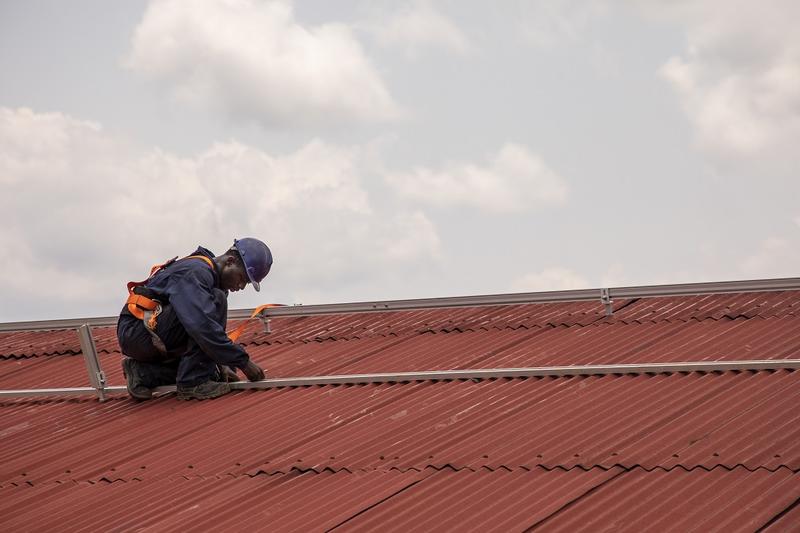In remote areas in places like the Democratic Republic of Congo (DRC), where patients often have to walk for hours through the bush to get to a hospital, many health centres struggle with a very basic issue: a lack of access to electricity. Médecins Sans Frontières/ Doctors Without Borders (MSF) teams have been coping with this logistical challenge for decades, usually by using diesel generators. But in the DRC´s South Kivu province, MSF teams have taken advantage of technological advances to find a cheaper, more effective and more sustainable solution.
In a place like Kigulube in South Kivu, where the population lives in villages that are scattered throughout the hills, inhabitants get around by motorcycle when they can. If not, they walk for hours. Adding to the difficulty of the population is that the region is suffering the effects of clashes between armed groups active in the area.
“Kigulube hospital is in the heart of a jungle, surrounded by bad roads and paths full of stones. People have a hard time getting to any health care post,” explains Balbastre. That means that in a case of emergency, it can be very difficult to reach the nearest city with a fully equipped hospital.
“The key areas for saving lives in a hospital are the operating room and the intensive care unit, and these require a continuous and reliable power supply” says MSF’s medical coordinator in the DRC, Chiara Domenichini.
The use of generators, the most common option when it comes to providing electrical energy in remote areas, poses several challenges. One of them is the enormous difficulty of transporting fuel to places that are not always accessible by land cruisers or trucks. Transporting diesel by motorcycle or by air is extremely costly and has many logistical challenges.
Although solar energy has been around for decades, the power systems and batteries available until recently did not make it viable - in terms of price, capacity and life span - for uses such as powering a remote hospital located in the middle of the hills of South Kivu. Batteries that could have been transported and maintained in such a complicated environment did not have enough storage capacity to guarantee the operation of complex biomedical equipment over long periods.
But the availability of new technologies has changed this. “We are using the latest generation lithium batteries that have not even been commercialized on a large scale,” explains Miguel Balbastre, one of the people in charge of MSF´s project that provides Kigulube hospital, in the area of Mulungu, with solar power.
Before installing a photovoltaic system in Kigulube hospital, MSF opened its first solar-powered hospital in South Kivu a year ago, in the Kusisa area in the mountainous Ziralo region.

The installation in each of the two hospitals consists of 100 solar panels and seven batteries capable of accumulating the energy needed by each center for two whole days. Each of these storage units has a lifespan of at least five years (although it may be two or three times longer), with the added benefit that this type of assembly includes an electronic control unit capable of controlling both the charge and the release of energy from each of the batteries, greatly extending their lifespan. In addition, this control unit is able to detect anomalies and can be controlled remotely with an internet connection, so that technicians can monitor the system from anywhere in the world. Everything is designed to guarantee a continuous and autonomous supply, but in the unlikely event of failure, there is a back-up diesel generator ready to take over and maintain the hospital's power supply at all times.
“This solar-powered facility makes a big difference to the treatment we can offer patients in Kigulube hospital,” says Dr Pacifique, director of the hospital. “Before, we sometimes had to operate in the dark because there was no lighting anywhere in the center. Now, all the rooms will have electricity to ensure adequate medical treatment for patients,” he adds.
The MSF teams have taken on the challenge of transporting all this equipment from Europe to a remote corner of Africa, on a journey that resembles an adventure story. “The panels travelled by boat along the Suez Canal to Tanzania, where they were unloaded at the port of Dar es Salaam,” explains Miguel Balbastre. “From there, they crossed Tanzania and Rwanda by truck until they reached the border town of Goma, in the DRC. They crossed Lake Kivu again by boat to the city of Bukavu, the capital of South Kivu province, and from there they went by helicopter to the Mulungu area. And finally, around fifty porters carried them to the hospital.”
Obviously, the installation of such a system requires a strong initial investment, but taking into account the enormous savings in fuel and in not having to transport the fuel by motorcycle or helicopter, the outlay is expected to be recouped in only two or three years. After that, the annual cost of running the system is 95% less than with generators.
MSF is an emergency medical organization and will sooner or later redirect its resources to other regions, but the tens of thousands of inhabitants of Kusisa and Kigulube can continue to have functional hospitals. As the medical coordinator explains, “when MSF is gone, they will not need extra money and will not have the usual difficulties of getting the generators to work. They will work autonomously and we will ensure that all the equipment we leave can continue to function and do the work that is needed.”


